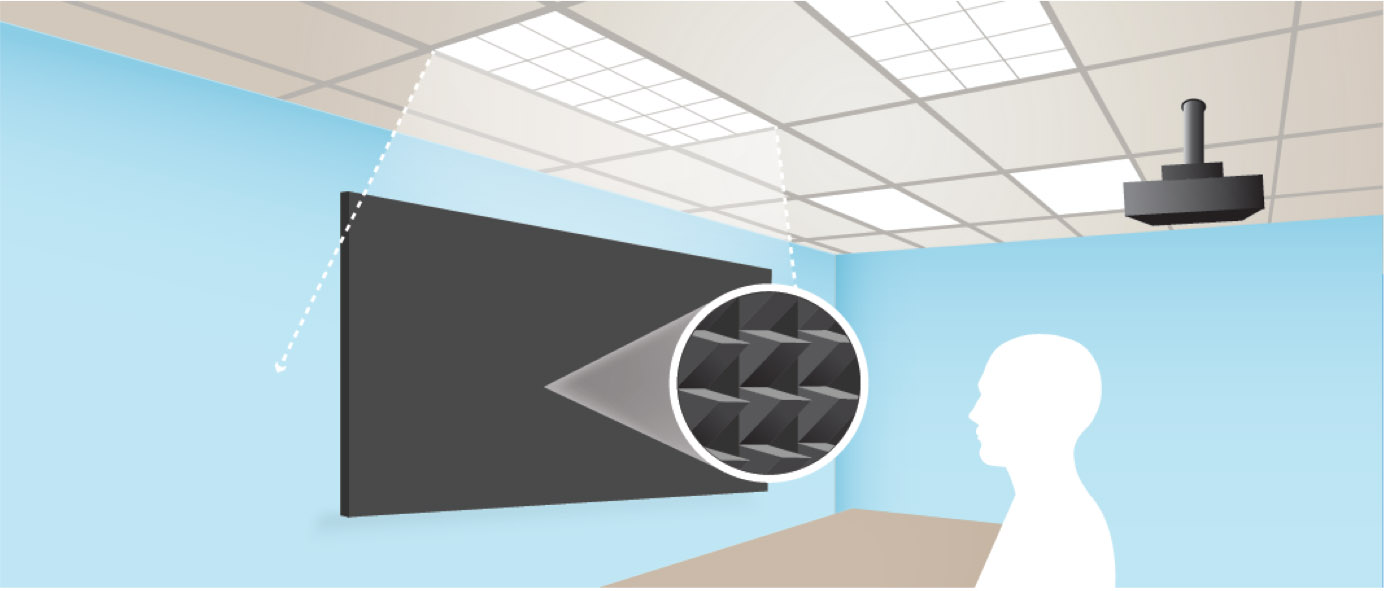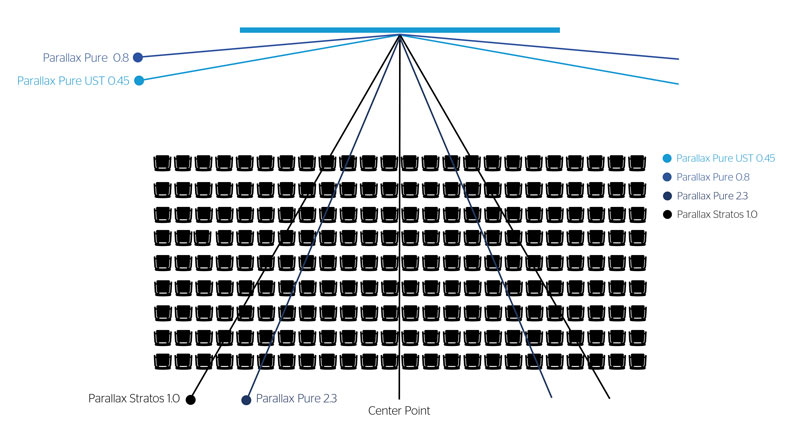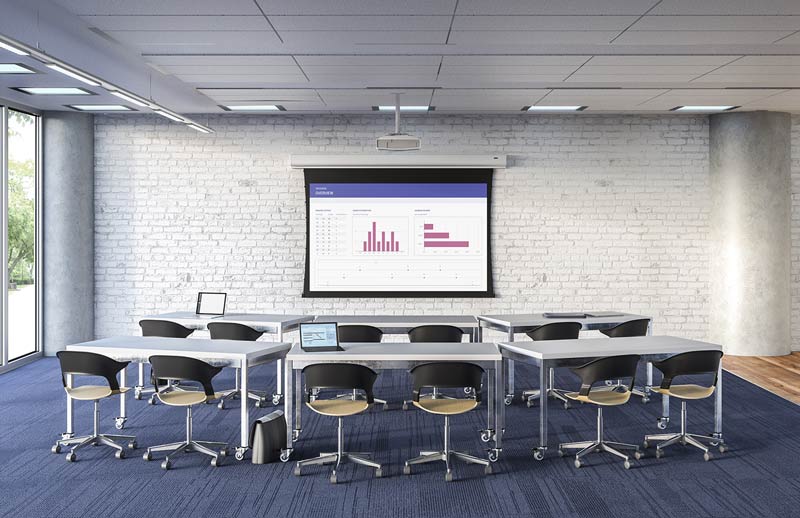Selecting the Best Projection Screen for High Ambient Light Areas
In the world of displays, it truly is all about the image we see on screen. We are embarking on a new visual era with more content created in High Dynamic Range (HDR) along with much wider color gamut (i.e. Rec.2020). Add in projectors that can display these enhanced images on a high-quality screen, we are finally able to approach what the human eye truly sees in nature.
In the world of screen selection, the variables of projection are:
- Content
- Screen
- Projector
- Ambient light
- Viewer location
It all begins with the viewing environment. In a darkened room, projected images don’t compete with ambient light. Great content, a high-performance projector, and a high-quality HD Progressive screen will render an exceptional viewer experience. However, reality is rarely so controlled.
Totally darkened rooms are hard to come by outside of a theater environment. Ambient light is almost always a part of the projection equation. Physics teaches us that ambient light comes with two variables: intensity and direction. Depending on the levels of each, the ambient light that falls on a projection screen will wash out image contrast, color saturation and dynamic range.
Generic matte white screens are designed to evenly reflect the projected image back to the viewer without gain or loss from the screen. In a completely or mostly darkened room this is great, because what you project is what you see. The limitation with a matte white screen is uncontrolled ambient light falling on the surface and washing out the image.
This has been a major projection impediment… until recently.
Multiple Solutions to Rejecting Ambient Light
The good news is that just as content and projectors have evolved, projection screens have also evolved. With the introduction of ALR screens, the problems that ambient light introduces are solved. This allows the quality of the content and the projector/screen combination to shine through.
There are multiple solutions available - each with specific benefits.
Gain screens use a surface so that angle of incidence of the ambient light will equal the angle of reflection. This means that a gain screen will collect and reflect more of the projected light back at the viewer in exchange for a narrower viewing angle. You can achieve increased brightness and color saturation with low lumen output projectors using gain as a design tool, keeping in mind viewer location and proper projector selection. When all of these variables are taken into consideration, gain screens can be a solution for rejecting ambient light.
Gray projection screens increase image contrast, particularly in a room that is not completely dark. These are also known as Contrast Based Ambient Light Rejecting screens. The gray color of the screen absorbs some of the ambient light rather than reflecting it as a matte white screen would. The same image in that space might appear washed out on a white screen, whereas the gray screen maintains and enhances contrast for viewers.
It is critical to understand the need for different screens for different projectors and applications. One size does not fit all. It is also important to know that all ALR solutions are not created equal.
True Optical Ambient Light Rejecting screens are specifically designed to reject higher levels of ambient light from specific angles in a room. This makes the image brighter than the other solutions described above. Light in the room is not reflected in the image, preserving contrast, color saturation and dynamic range.
 Side by side illustration of ALR surfaces; True Optical ALR screens provide the best image contrast, color saturation and dynamic range.
Side by side illustration of ALR surfaces; True Optical ALR screens provide the best image contrast, color saturation and dynamic range.
Understanding ALR
ALR screens have a few unique design considerations. When using them, understand that ALR screens work best when the ambient light and the projector’s light are coming from different directions.
According to Tim Henson, Screen Technology Director at Da-Lite, “The thing to keep in mind with ALR technology is projector location. The unique properties of ALR screens make it critically important to position the projector within the proper projection angle for each screen. Doing so will maximize the screen’s ALR properties.” He added, “Ultra-short throw projectors create a completely different challenge for ALR technology because of the short focal length and angle of the projected image. Parallax® Pure UST 0.45 solves this problem with a screen material tuned specifically for ultra-short throw projection.” When fighting reflections from the walls, incoming light from overhead lamps, or sunlight coming through a window from the side, then an ALR screen is the answer. Some manufacturers present a single dark gray vinyl surface as their ALR solution. In that case, it operates at a single level of light rejection whereas the multi-layer approach of True Optical ALR adds additional light rejection thus becoming more apparent in performance. Think of the multi-layers amplifying the effect over a single layer.

 Illustrations of the microscope saw-tooth layer that blocks light from above in True Optical ALR surfaces. Top Image: Parallax Pure 0.8 for standard projectors. Bottom Image: Parallax Pure UST 0.45 for ultra-short throw projectors.
Illustrations of the microscope saw-tooth layer that blocks light from above in True Optical ALR surfaces. Top Image: Parallax Pure 0.8 for standard projectors. Bottom Image: Parallax Pure UST 0.45 for ultra-short throw projectors.
True Optical ALR screens consist of a series of optical layers. There is a highly reflective base layer. On top of that a micro-layered optical lens surface absorbs light. This optical lens surface is itself made of two layers. One special layer is shaped like a microscopic saw-tooth that blocks light from above, and the second is a diffusion layer that filters out off-axis lighting. This results in high-contrast, bright images in well-lit environments. The reflective base then compresses the brightness into a narrower half-gain viewing cone, enhancing the picture’s luminescence. Properly designed ALR materials serve multiple roles of enhancing the picture’s brightness and dynamic range, with more defined black levels.
Understanding Viewing Angles
The center point of viewing, on any projection screen, is the brightest. As the viewer moves to either side, or “off-axis,” the image becomes less bright. With True Optical ALR, light is rejected from the center line of the screen and continues at a diminishing amount all the way to the half gain angle of the screen. This results in a surface designed and manufactured to provide very wide viewing angles while maintaining a high percent of ambient light rejection.

True Optical ALR screens offer wide viewing angles for optimal image quality regardless of seat location, as illustrated above. The Parallax 2.3 viewing angle is narrower than .8 and UST 0.45; however, image brightness is maintained even when off-axis due to its very high gain (2.3).
This is important in screen selection since viewing at a position located at greater than the half gain angle would render a less than perfect image for the viewer. The viewing audience is taken into consideration with the selection of any screen, but most especially an ALR screen. Keep in mind when designing for tiered or auditorium seating that there is also a vertical half gain. Parallax screens range from 0.45 ultra-short throw to 2.3 standard throw gain. As gain increases and the resulting brightness increases, the viewing angle decreases.
Understanding Throw Distance
Throw distance is also important to consider when designing a room. Rhen Taylor, Product Manager at Da-Lite points out that “Parallax 0.8 and 2.3 utilize lens throws that are at least 1.5:1 or 1.8:1 respectively to produce enough distance between the projector and the screen to capture the full effect of ALR. This distance creates the separation between the screen layers that reject ambient light and layers that reflect the full energy of the projector’s light back to the audience. The separation of ambient light and projected light opens opportunities for a screen to be installed in a very bright environment (including windows with sunlight) while maintaining exceptional image quality for the audience. The availability of Parallax screens enable projection systems to be integrated into environments previously thought of as “difficult” for two-piece projection because of the detrimental effects of ambient light on a projected image. ALR screen choices bring the projection system back into the forefront of the AV room design. If there is light, bring on the light; a well-designed ALR screen surface can handle it.”
The tried and true generic matte white screen is the “what you see is what you get” technology but does not respond well to ambient light. Enter the gray Contrast Based ALR screen designed for increased contrast and use in rooms with some ambient light. The newest player on the team is the True Optical ALR screen designed to reject higher ambient light coming from all angles and provide a bright image with good contrast and color saturation. Selecting the right ALR screen today is truly integral to getting the most out of your projector.

Parallax surfaces are available in electric and fixed frame screens. Unlike flat panels, these screens are virtually glare-free. They offer more sizing flexibility than flat panels as well.
“To create amazing experiences, customers need solutions that enable them to install large projection screens in all types of environments, and controlling light levels isn’t always an option. In the past, high levels of ambient light diminished the experience or required substantially more expensive products.”
- Steve Durkee, Legrand AVD Senior Vice President & General Manager - Commercial.
Downloads
-
Parallax Pure 2.3 Surface

Horizontal Half Angle: 23º
Vertical Half Angle: 15º
Ambient Light Rejection: 96%
-
Parallax Pure 0.8 Surface

Horizontal Half Angle: 85º
Vertical Half Angle: 17º
Ambient Light Rejection: 96%
-
Parallax Pure UST 0.45 Surface

Horizontal Half Angle: 80º
Vertical Half Angle: 55º
Ambient Light Rejection: 95%
-
Parallax Stratos 1.0 Surface

Horizontal Half Angle: 30º
Vertical Half Angle: 30º
Ambient Light Rejection: 80%
- Related Products
- Resources
- Videos
Related Products
Resources
Product Downloads
Videos

Parallax ALR InfoComm 2019 Promo

Da-Lite Parallax Comparison

Introducing Parallax Stratos


